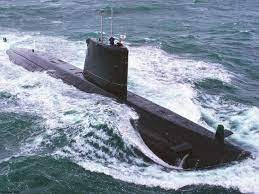Jawad Falak
On 14th February, a significant milestone for the Pakistan Maritime sector was achieved as the Keel-Laying Ceremony for the second Hangor-Class Submarine were carried out. The Chief of the Naval Staff, Admiral Naveed Ashraf was present at this occasion as the Chief Guest. This was in continuation of the Hangor class project as construction work of the first submarine to be made at KS&EW Pakistan, had been initiated in December 2022 and the submarine is currently at an advanced stage of construction.
The Hangor class project is an outcome of a defense agreement between Pakistan and China. This agreement comprises of the development of up to eight Hangor-class Submarines of which four submarines will be built at Wuchang Shipbuilding Industry Group (WSIG) in China and the remaining four will be constructed at KS&EW under a Transfer of Technology (ToT) agreement.
These conventional modern submarines will be equipped with the latest weapons and sensors, and the submarines are expected to have installed an AIP system onboard will significantly enhance their submerged endurance capability. AIP stands for Air-independent propulsion (AIP), or air-independent power, which is a type of marine propulsion technology that allows a non-nuclear submarine to operate without access to atmospheric oxygen by surfacing or using a snorkel. AIP in this manner enhance the durability of diesel submarines underwater and also make them stealthier than nuclear submarines.
The eight Hangor Class submarines will significantly strengthen Pakistan Naval defense. The Pakistan Navy is likely to boost its anti-access/area denial (A2/AD) capabilities in the region especially the Exclusive Economic Zone after the project is completed. Additionally, the submarines will have the ability to carry and launch nuclear capable missiles which will bolster deterrence and improve strategic stability in the region which is currently under pressure from ramifications of Great Power competition.
However, the name of Hangor carries much significance in itself as it carries a heritage that is famous in both regional and global naval tradition. Hangor, meaning Shark in Bengali, was a French made Daphne class submarine that served in the Pakistan Navy since 1966. In the Indo-Pak war of 1971, Hangor would find itself in the thick of fighting.
In August 1971, Hangor was deployed in November of the same year to gather intelligence outside Bombay as regional tensions arose. During this time, it observed the movement of a large Indian flotilla heading towards Karachi. Hangor, not having clearance to engage the Indian Navy as of yet could only relay this information to the homeland but this communication was intercepted by the enemy.
The Indian Navy then acting on the information dispatched two British built Blackwood frigates, Kirpan and Khukri, to find and destroy Hangor. However, a day later, on December 4, Hangor received clearance to engage and destroy the Indian naval vessels, setting the stage for a showdown in South Asian waters.
On the night between 9 and 10 December, Hangor was making for Kathiawar Coast when it detected the two Indian frigates. Moving to intercept them, Hangor initially launched a single torpedo against the Kirpan but for some reason it did not strike the target despite being on the same path. This not only alerted Kirpan but Khukri as well, which adopted an intercept course for Hangor. Hangor’s targeting team quickly reacted and fired off a second torpedo on the approaching Khukri.
This torpedo sped and struck Khukri, resulting in an explosion as the ammunition storage area, also called a magazine of the ship, was struck. Through this feat Hangor’s name became preserved in the annals of history as the first submarine after World War II to sink an enemy ship while also giving India its largest naval loss in history with deaths of 18 officers and 176 sailors.
Despite the tragic end of the 1971 war and the Indian thirst for vengeance against it, the Hangor survived and continued to serve the Navy till 2006 before retiring. Now with the start of the Hangor project, the legacy of the Hangor name as a defender of honor and maritime boundaries is expected to endure.
The author is graduate National Defence University (NDU) Islamabad in International Relations.







